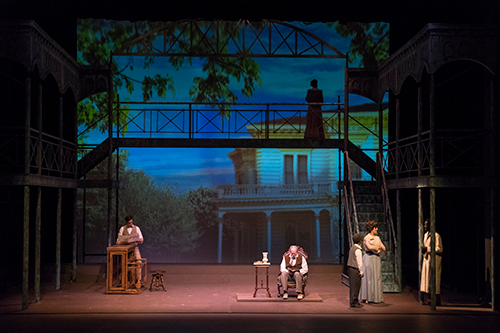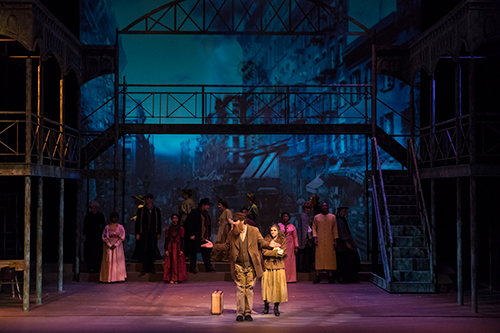Learn
Set Designer
A set designer brings an audience into a new world! Whether that world is a civilization in a galaxy far, far away or a house right down the street, a set designer attempts to create this world on a blank stage.
In the introduction to this lesson, you learned a little about David Korins, the set designer for the mega-hit Hamilton. Read "Hamilton Set Designer on Creating the Stage of the Century" from Vogue to learn more about his involvement with this revolutionary production!
Types of Sets
Box Set
A box set is comprised of 3 walls that surround the actor's performance space. Box sets are typically very realistic and very detailed.

This is an example of a box set from Theatre Tuscaloosa's performance of The Real Queen of Hearts Ain't Even Pretty. Image used with permission of Theatre Tuscaloosa. See larger version of box set example here.
These walls are made of flats. A flat is a piece of scenery that is flat and painted to represent something in the background of a set. Some flats are hard and made of wood; others are made of a heavy duty fabric stretched over a frame.
Additionally, because of the difficulty of making any changes to the box set during the duration of the show, these are referred to as permanent sets. So what does this mean?
Box sets are perfect for shows of a realistic nature. A show that attempts to convince the audience that the world on the stage is real and the actions are happening in front of their eyes!
Unit Set
A unit set is a set that includes free-standing elements. Unit sets allow for much variety in the set because the pieces are moved on and off stage.

This unit set example is from Theatre Tuscaloosa's performance of Ragtime. Notice how many movable pieces make up the set, including the staircase in the middle of the stage that a man is standing on! The prop was wheeled around the stage at various times during the performance. Also notice the backdrop is a projected image. Image used with permission of Theatre Tuscaloosa. See larger version of unit set example here.
A modern unit set relies on projections. A projection is when an image that is cast or displayed on a surface; it's very similar to how a movie is displayed on a movie screen. Projections are a lot like the traditional painted fabric backdrops used in theatre for centuries. However, digital projections are quickly becoming the go-to backdrop for theatres across the world – and not just for high budget produtions!
In the article "Learn How to Start Using Projection Backdrops with Theatre Avenue" from WellAttended, Mitch Stark from Theatre Avenue talks about his work as a poster and projection designer for theatrical shows. According to Stark, projection backdrops allow for a more realistic and dynamic background than traditional painted flats. They can include moving elements (including animation effects like rain or snow), video elements (like a crackling fire), and mood/color shifts (such as a day-to-night gradation). You can also use the projector to seamless fade-in, blackout, or instant transition from scene to scene. Stark states, "Projections can also be painted in a range of styles, from something very light and cartoonish to something completely photo realistic. And they can powerfully punctuate moments in a story. For example, imagine yourself directing "The Lion King, Jr." We have a projection called 'Hot Sunrise' that is one of our most popular; it's a simple animation of a sun slowly rising that spans the course of the opening song. When you see this brilliant wash of color fill the cyclorama, it brings your scene to life – suddenly it feels like Broadway. Artistically, there are no limitations."
Additionally, this new medium is often much cheaper than traditional backdrops. Instead of needing heavy equipment to hoist and hold your heavy physical backdrop (not to mention the countless hours spent drawing and painting it or the weekly fees of renting a traditional drop), with this digital option, a production only needs a projector, a screen (which can be built for around $100, rented, or bought), a laptop, and cables. The artwork is additional, but it could be created by the designers using a digital creation tools or purchased a digital file through a vendor which can be kept and reused over and over again.
Although projection is not a new technology, it has begun finding its way into more theatres across the country in recent years. You will often see unit sets in musicals because there are often many different settings that have to be shown during the duration of a 2-hour show. Check out some of the examples below or browse through premade backdrops by show offered by a theatrical company.
The musical Ragtime is set in the early 20th century and it tells the story of three groups in the United States: African Americans, upper-class suburbanites, and Eastern European immigrants. The backdrop changed frequently depending on which group was onstage, and different projections were used to indicate the setting while the larger pieces like the moveable staircase, balconies, and catwalk stayed on stage.

The wealthy, white family in their home in New Rochelle, New York. Image used with permission of Theatre Tuscaloosa.

Eastern European immigrants arrive at Ellis Island, as indicated by the Statue of Liberty projected on the backdrop. Image used with permission of Theatre Tuscaloosa.

The immigrants settle in Harlem, New York, and meet several of the African American characters. Image used with permission of Theatre Tuscaloosa.
Curtain Set
A curtain set is one that uses hanging fabric to provide the location of the play or scene. Curtain sets are made out of drops, or pieces of fabric that are hung from the ceiling of a stage and act as background scenery.

This curtain set from a production of The Miss Firecracker Contest has a blue backdrop with a red and white striped drop in front of it to provide depth to the scene. (c) 2007, UA Theatre and Dance. Image used with permission.
A curtain line can also be made of a scrim, which is a thin piece of fabric that can be used for special effects once light is projected either in front of or behind it. Curtain sets can be used when budgets are limited. A designer only needs to focus on a few pieces and allows the curtains to stand in as walls, for example.

You saw this Ragtime set of Theatre Tuscaloosa's earlier in this lesson, as an example of a unit set. This set also uses a scrim where different backdrop images are projected. In this scene, the projected backdrop is a sunset, while the photo you saw earlier had a projected backdrop of city buildings. Image used with permission of Theatre Tuscaloosa. See larger version of this set that uses a scrim here.
Comparing Sets
Unit sets and curtains sets are known as minimal sets. How does that compare to a permanent set?
Prism Set
The ancient theatrical device that has begun to see a resurgence in modern theatre is the prism set. This type of set uses 3 pieces of wood nailed together to form a triangle. A new scene is painted on each of the sides of the triangle, which allows for scenes to be changed easily.
See an example of a prism set here. In this example, notice how each side of the set has a different design, including the side of a house and a field of trees.
Dressing a Set
Dressing a set is when set dressers add furniture and other props to the stage to make it look as it will during the performance. This job is often separate from a prop master who handles various props and objects that appear in a scene or a set designer who designs the overall space. Set dressers are literally dressing the physical space of the set and traditionally work under the set designer on a production.
Dressing the set is an important step from taking the stage from the ground plan to the final product an audience sees on stage. The ground plan is a bird's eye view of the set in relation to the stage or theater space. They include the locations of major elements of the set, such as walls and scenery, and also show the locations of doors, windows, staircases, and platforms. Ground plans are always drawn to scale, which means a unit of measure on the paper is equal to a unit of measure in the real world. Typically a ground plan will be rendered in 1/4 or 1/2 inch scale. For example, if you use a 1/2 inch scale, this means half an inch on your paper will represent one full foot in actual reality. You might hear them called stage plans or floor plans.
Ground plans are essential tools for directors during the early stages of the production. The ground plan is the first view of the set and helps the director and actors know where everything is in the world of the play. You'll learn more about ground plans in the next lesson.
Rendering
After the ground plan has been complete, the next step is called a rendering. What is this?
Open Performing Arts Shop and scroll down to see examples of ground plans and renderings.
Different Types of Stages
Remember in an earlier lesson we discussed the different types of stages. Do you remember what they are?
As a designer, you must know the type of stage and the constraints created by that stage. For example, you would not be able to put a box set on a thrust stage. Why? A box set must have a wall on 3 sides. On a thrust stage, the audience's view would be blocked by the walls. This would block an audience's sight line, which is the line of sight from audience to the action on the stage. A proscenium stage has a curtain line, or the specific area on the stage where the front curtain hangs, while an arena stage does not.

